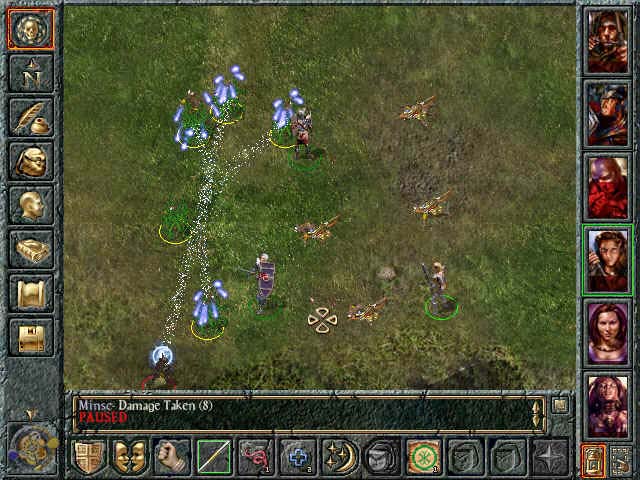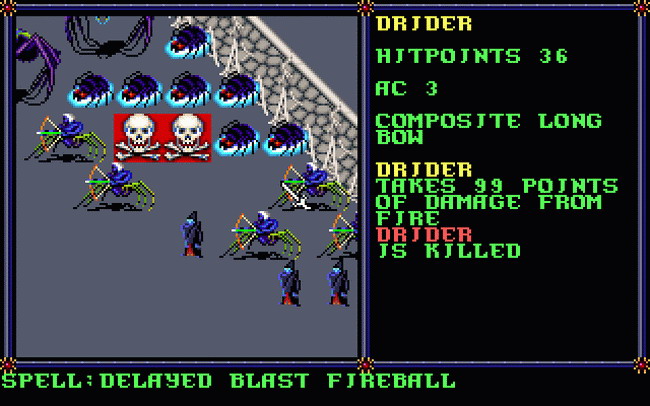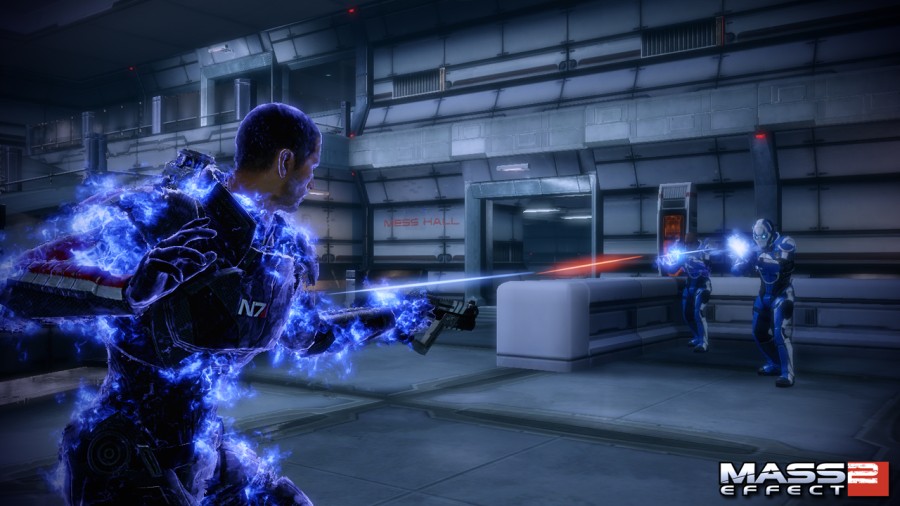In the early days of computer and console role-playing games, turn-based combat was the norm. This was not a compromise imposed by technological constraints, as one might suspect. Most early computer and console video games, influenced by the arcade, were twitch-based action games. Including real-time combat in an RPG would have been no more difficult than including it in any other genre. Early RPGs like Wizardry, Might & Magic, Ultima, and The Bard’s Tale adopted the turn-based combat mechanic by choice, because their designers took their cues from pen-and-paper RPGs like Dungeons & Dragons, which employed turns and dice rolls to simulate combat. This design resulted in combat systems that challenged a player’s ability to build and develop characters, and to think tactically in battle, rather than relying on fast reflexes and gamepad (or, at the time, joystick) mastery.
Some of these games, like The Bard’s Tale, presented turn-based combat as a series of menu choices. The player would consider the strength and number of the enemy, the hit points and supplies of his or her party, and then select (for example) to Attack, Defend, Cast Spell, or Flee. Other RPGs, like Ultima 3 and SSI’s Gold Box series of AD&D games, presented combat on a separate battle screen, where the player and the computer took turns moving party members and enemies around a map like figurines in a tabletop war game.
As time passed and the appeal of video games widened to include Madden-loving frat boys and Doom-obsessed shooter fans, RPG developers began to suspect that they could attract a wider audience by making RPG combat more action-oriented. This theory was proved beyond all reasonable doubt by the massive success of Blizzard’s Diablo, which had originally been designed with turn-based combat but transformed mid-development into a non-stop action click-fest.
Soon after Diablo’s release, Bioware bridged the gap between turn-based and real-time combat with the innovative “pausable” combat system in Baldur’s Gate, which presented combat in real time but permitted the player to pause to use items and issue orders. (Square’s active-time battle system, which set turn-based combat to a timer, signaled a similar trend in Japan, although pure turn-based combat continues to thrive in the east.) First-person RPGs were also influenced by the astounding success of the first-person shooter genre and adopted many of its conventions in hybrid shooter-RPGs like System Shock 2
and Deus Ex
that substituted real-time shooting for turn-based combat.

In Baldur's Gate, Bioware introduced the "pausable" combat system, a version of which it still uses to this day.
There have been turn-based combat holdouts. Fallout 1 and 2, which released around the same time as Baldur’s Gate and its expansion, hewed to a traditional turn-based combat mechanic. Troika Games developed the excellent Temple of Elemental Evil
in 2003, which also employed pure turn-based combat. But in recent years, the subgenre has all but died in the west. (I’m not counting games like the recent King’s Bounty
and its sequels, which I consider to be strategy games more akin to Heroes Of Might & Magic
than the main, RPG entries in the Might & Magic series.)
We could argue endlessly about how to define the RPG genre, but in my opinion, one of its key identifying characteristics is the separation between player skill and character skill. If my desert ranger in Wasteland is an awesome marksman, then he is likely to hit his target, regardless of my mouse and keyboard skills. In an action RPG, though, this distinction is minimized. My Infiltrator in Mass Effect 2 may have great stats, and those stats will definitely help his aim. But no matter how high his level, he will always be a better shot if controlled by a veteran FPS gamer.
Don’t misunderstand. I enjoy pausable combat and real-time combat. Some of my absolute favorite RPGs, such as Dungeon Master, Ultima Underworld 1 and 2, and The Elder
Scrolls series
, demonstrate how fun real-time combat can be. All I’m saying is that I like turn-based combat, too, and I miss it. One play-through of EA3D’s excellent (and free) browser-based RPG Dragon Age: Journeys reminded me how much I miss this game mechanic.
Yes, pausable combat mitigates the issue to some extent. The combat in Mass Effect 2 and Fallout 3 is a tense affair, arguably better played on a console with a gamepad, but the ability to pause, survey the battlefield, and cue up actions (and sometimes just take a deep breath) helps bring turn-based combat skills into play. But pausing is still a compromise. Would it be so difficult for RPGs with pausable combat to include an option for full-blown turn-based combat, so that gamers seeking a slower, more measured experience would have that option?
The trend toward action-based combat does not appear to be changing. To the contrary, RPGs are hurtling headlong in this direction. Previews of Dragon Age 2 suggest that combat in that game will be more action-oriented than it was in the first Dragon Age
, which itself was more action-oriented than the combat in Baldur’s Gate. Even a game like Hunted: The Demon’s Forge
, which is being marketed by Brian Fargo, the founder of Interplay, as a return to CRPG roots, borrows its combat system from Gears of War, not The Bard’s Tale.
So is this post really a eulogy to turn-based combat in western RPGs? In the video game industry, the death and reappearance of game mechanics is routine. If Telltale brought back point-and-click adventure games – arguably the least “action-packed” of all video game genres – then anything is possible. All it would take is one fantastic turn-based combat RPG to succeed in the marketplace, and we would see a renaissance of this style.
In the meantime, we can always look to Japanese RPGs like Dragon Quest 9 and Etrian Odyssey 3
for our turn-based combat fix.


Or *cough*Indie RPGs*cough* … 😉
Seriously, check out the Avernum and Geneforge series by Spiderweb Software, Knights of the Chalice by Heroic Fantasy Games, the Eschalon series by Basilisk Games, Swords & Sorcery: Underworld by Classic Games Remade, and a slew of others forthcoming for some western-style turn-based RPGs. And that’s just the games / series that have had new titles released in the last year or so.
Yeah, the mainstream publishers are pretty much abandoning the field in search of specific variations on a universally best-selling game, but they are leaving a substantial niche behind. The indies are taking advantage of it. You won’t get the production quality you’d enjoy from a game with a $20 million budget, but they should help scratch the itch.
Thanks for visiting, Rampant Coyote. You’re right — I probably should have at least mentioned the indie RPGs, but I’ve been saving that topic for a separate post. Since you brought up the subject, I will second your recommendations. For gamers who can get past the graphics, these and other indie games provide a classic old-school RPG experience. Many of them have demos as well.
Thanks,
That was most helpful, I have been driving myself crazy doing this search…
I disagree with the graphics part. Eschalon series is pretty polished, and I myself as well as a few up-coming indie projects (Dead State, Age of Decadence) are all pretty anal when it comes to graphical quality. I think the notion that “getting past the graphics” is dying pretty fast now.
Ruben — my point was only that the average RPG player, accustomed to the graphics in big-budget RPGs, may be turned off by tile-based, isometric graphics, no matter how good they look. But hopefully I am underestimating the general RPG audience! I agree with you that the graphics in indie projects have been looking better and better lately.
By the way, I was not familiar with Splintered Core but it looks very cool!
“Soon after Diablo’s release, Bioware bridged the gap between turn-based and real-time combat with the innovative “pausable” combat system in Baldur’s Gate, which presented combat in real time but permitted the player to pause to use items and issue orders.”
What a blooper in an otherwise ok article, but I guess it’s the illiteracy common to all modern gamers today: Blizzard invented this, Bioware innovated that, Bethesda redefined it. Modern gamer = ignorant pleb with absolute zero gaming lore. The system used in and made famous by point&click Bioware games where you can pause an otherwise real-time game is called RTwP, “Real-Time with Pause” and it’s been in ‘mainstream’ use since at least Darklands (1992).
Thanks for posting, denizsi.
I’ll confess I never played Darklands and did not know that it featured pausable combat (or RTwP, if you prefer). Thank you for bringing this to my attention. I would like this blog to be as informative as possible.
Regarding the rest of your comment, I think I understand your point, but I also believe that some degree of shorthand is useful in order to keep a blog post focused and to reduce tangents. The challenge is getting the balance right between shorthand and over-simplification.
Excellent article. Thank you very much for writing it.
I don’t think turn-based is dead – at least I prefer to think of it as “sleeping.”
As you say, it’ll just take something like Dead State to be successful.
Trends come and go – and sooner or later the attraction for tactics and strategy, as opposed to how quick one can hit a button or aim a reticule, will return.
I look forward to the day when the internet helps games become like music, comics and prose are becoming – less big budget pushes and more smaller niches being fed successfully at a level that can be profitable to those satisfying the smaller niches.
Thanks for the kind words, Merin. I’m glad you liked the article.
I agree — the larger the video game audience grows, the more potential there is for small and indie RPG developers to produce profitable games that cater to specific niches. And as we have seen, a niche genre can become mainstream overnight in the video game industry.
Hey!
Great article!
Finally I don’t feel all alone anymore in my craving for turn-based RPGs!
And great reply by Rampant Coyote!
I didn’t know *any* of those turn-based goodies! They should keep me busy for a while!
🙂
Is anyone here interested in a project to create a multi-purpose turn-based RPG game simulator?
I’d like to make a game engine to simulate original turn-based pen and paper RPGs, such as AD&D, Cthulhu, GURPS, etc., using a full 3D engine: http://www.mrpgs.net
The purpose is to make it easier and cheaper to produce many different good turn-based computer RPGS, using any original game rule-set, or new made-up ones. Keywords are re-usability, modularity, component object engine, plugins.
Obviously this is a big idea and too big to realize for one person alone.
Thanks for posting, Mark, and good luck with your project.
HUM, very interesting article.
I would like to read anyday one very important aspect never discussed as far as i know, which is the influence of loot (weapon and armor) when having to choose between turn based or real time RPgs.
Also as a side subject someone will be able to perhaps explain me why in a game like diablo (specially D2) that encourages the player to collect loot there is very little storage space, unlike for ex in BG series where it was nearly endless.
I remember enjoying a lot a mod for D2 that precisely provided you with limitless storage space.
Knights of The Chalice is a turn-based RPGr-s dream. Some limitations in terms of character customization variety, as well as old-school graphics look, but as a turn-based combat engine, I don’t see a better game out there. 🙂 Dig it. Also Wizardry 8 circa 2001, but that’s a serious collector’s item at this juncture. Wonder if GoG will ever get on that one…
Thanks for the recommendation, Masta De Gumbo. I had not heard of Knights of the Chalice, but it looks like something I would really enjoy. I am going to try it out and maybe write a blog post about it.
Also if they took the very decent graphics engine in Xcom enemy unknown (remade turn based recent game) and used it to make a turn based RPG then you would see something pretty special.
Depends on the software makers, i’d like to see it.